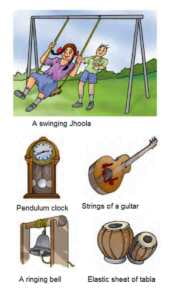Table of Contents
Motion and Measurement of Distances Exercises question answer solution
1. Give two examples each, of modes of transport used on land, water, and air.
Answer: We use various means while travelling to multiple places. We can use their names here. They are:
Land Transport: Bus, Train, Motorcycle, Cycle, Tram, Rickshaw etc.
Water transport: Ship, Boat.
Air Transport: Aeroplane, Helicopter.
2. Fill in the blanks:
(i) One metre is ______________ cm.
(ii) Five kilometre is ______________ m.
(iii)Motion of a child on a swing is ______________.
(iv)Motion of the needle of a sewing machine is ______________.
(v) Motion of wheel of a bicycle is______________.
Answer: (i) 100 cm. (ii) 5000 m. (iii) Periodic. (iv) Periodic. (v) Circular.
3. Why can a pace or a footstep not be used as a standard unit of length?
Answer: Pace or a footstep length varies from person to person. If we use them in measuring the distance, other people may not know the exact distance between two locations.
To solve this issue, we use a standard accepted convention. This convention is the International System of Unit (SI). In SI 1 meter equals 100 centimetres and 1000 millimetre.
4. Arrange the following lengths in their increasing magnitude:
One metre, 1 centimetre, 1 kilometre,1 millimetre.
Answer: 1 mm < 1 cm < 1 m < 1 km.
5. The height of a person is 1.65 m. Express it into cm and mm.
Answer: As per the International System of Units (SI).
One meter equals to 100 Centimeter and 1000 Millimeter.
So, 1.65 meters will equal to 165 Centimeter or 1650 Millimetre.
6. The distance between Radha’s home and her school is 3250 m. Express th
distance into km.
Answer: 1000 meter equals to 1 kilometre so 3250 meters will be 3.25 kilometre. So the answer is 3.25 Km.
7. While measuring the length of a knitting needle, the reading of the scale at one end is 3.0 cm and at the other end is 33.1 cm. What is the length of the needle?
Answer: Sometimes a used scale has broken zero. Using such scales from the beginning may result in a wrong calculation. So, In such cases, we use the number next to broken part and reduce the answer by that number. Similarly here we are using the measurement from the 3cm mark. So we will reduce the measurement by 3cm.
So, the answer will be 33.1cm – 3 cm, which equals to 30.1cm.
8. Write the similarities and differences between the motion of a bicycle and a ceiling fan that has been switched on.
Answer: Similarities
Both move in circular motion. Both have a fixed centre around which the body of fan and cycle wheel moves.
Differences:
The cycle also has rectilinear motion.
The driving force in a fan is the electricity while in a cycle it is the mechanical force of our feet.
9. Why would you not like to use a measuring tape made of an elastic material like rubber to measure distance? What would be some of the problems you would meet in telling someone about a distance you measured with such a tape?
Answer: Elastic material does not have a fixed length. It can be stretched to a bigger length. So we will get an error in measurement. Hence we do not use such tapes in the measurement of distance.
10. Give two examples of periodic motion.

Reference: NCERT Class 6 Scince Chapter 10.
Please send activites solutions of chapter 10 , 12 , 13, 14,